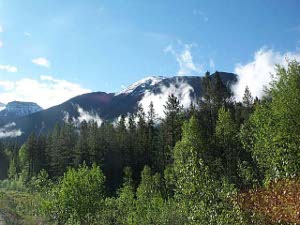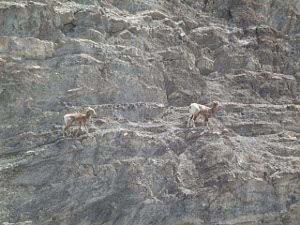 Rocky Mountains
Rocky Mountains Rocky Mountains
Rocky Mountains
We left McBride bright and early and reached Jasper National Park by 10:00, even with the hour lost going into Mountain Time. Tall craggy mountains surrounded us all day long, as we drove down the Icefields Parkway through the heart of the Canadian Rockies.
Moments after entering the Park we caught sight of several bull elk feeding by the side of the road. We remarked that this area has been a Canadian National Park for 100 years, and quite possibly generations of the animals are accustomed to people.
Tree line is quite low here, typically 5,000 to 7,000 feet, so all of the peaks were rocky and icy. The icefields are spectacular. We decided to pass  Grazing elk
the opportunity of walking on the glacier, but we did walk to several viewpoints and kept our camera snapping. We saw a beautiful cobalt blue glacier-fed lake. The color of these lakes is caused by the silt in the water.
Grazing elk
the opportunity of walking on the glacier, but we did walk to several viewpoints and kept our camera snapping. We saw a beautiful cobalt blue glacier-fed lake. The color of these lakes is caused by the silt in the water.
We were delighted, too, to see our first Rocky Mountain Bighorn Sheep, peacefully grazing by the roadside, rams, ewes, and lambs. The best sight was watching two ewes standing on seemingly impossible perches on a steep slope next to the highway. Hope you like the pictures!
As we drove south towards Banff, the highway grew more and more crowded, and traffic was less polite. We were quite astounded by a tour bus which pushed  Rocky Mountain sheep
up to less than one car length behind us, even though we were driving at the 90-kmh speed limit. Later the same bus swerved through two lanes of traffic to stop suddenly next to a bridge, not quite out of the traffic lane, to let the passengers view some roadside elk.
Rocky Mountain sheep
up to less than one car length behind us, even though we were driving at the 90-kmh speed limit. Later the same bus swerved through two lanes of traffic to stop suddenly next to a bridge, not quite out of the traffic lane, to let the passengers view some roadside elk.
Banff itself is just a mountain resort town; needless to say we went right on, to spend the night in Calgary.
Today marks the end of a certain phase of our trip. Since we left
California in February we've been, broadly speaking, in the Pacific Northwest, including Oregon, Washington, British Columbia, the Yukon, and Alaska. This land is typified by forests and mountains, filled with bear, elk, moose and  Bow Lakeother unseen wildlife. And, as we've learned, the northern part is heavily dependent on the extractive industries and tourism.
Bow Lakeother unseen wildlife. And, as we've learned, the northern part is heavily dependent on the extractive industries and tourism.
But Calgary is in the rolling Great Plains of North America. It's surrounded by cattle ranches and rolling hills. The effect is the same as descending from the Colorado Rockies to Denver.
We've decided that exploring the Great Plains and its people will take another long driving expedition, but that right now we have something else in mind. We plan to drive to the midwestern U.S. to begin tracing some of our relatives and ancestors -- a genealogically-based tour, if you will.
So, while we'll continue to sightsee as we go, our travel reports may be shorter and less frequent. We'll keep you posted.